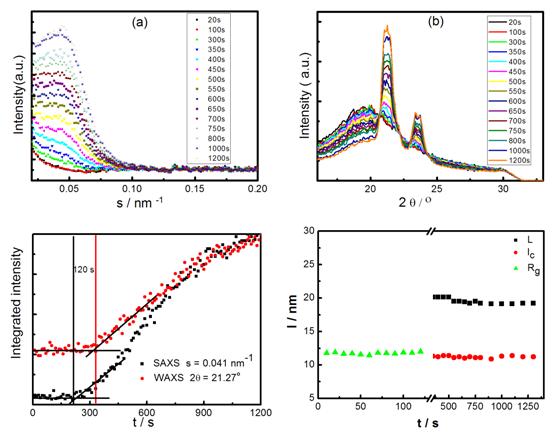| Crystallization Behavior of Poly (ε-capro1actone) and Poly (ε-capro1actone)/LiClO4 Complexes from the Melt |
| From: PublishDate:2013-06-15 Hits: |
Polymer crystallization is one of the most challenging topics in polymer physics. At present, there still lacks of clear understanding in the polymer crystallization, especially in the induction of crystallization of a polymer material.. Poly(ε-caprolactone) (PCL) is the ideal model to study polymer crystallization due to its particular properties. A team from School of Materials Science and Engineering of TianJin University investigated the melting crystallization behavior of PCL and PCL/LiClO4 complexes, to obtain insights of the structural evolution in the crystallization induction period. Their research has been published on August 23th, 2012 in CrystEngComm. This team has observed lag in the time resolved intensity change of wide angle x-ray scattering (WAXS) and small angle x-ray scattering (SAXS). The result indicates that the pre-ordered phase (according to SAXS) emerges in the induction stage prior to the appearance of finely ordered structure, or crystalline (according to WAXS). This discrepancy in SAXS and WAXS profile changes was observed during the isothermal crystallization of PCL and PCL/LiClO4 complexes. The results indicate that the initial crystallization of PCL and PCL/LiClO4 complexes can not be described by the nucleation and growth scheme. Meanwhile, the lamellar crystallites via transient intermediate states rather than forming and growing directly from the isotropic in an entangled polymer melt. The SAXS data collected in the crystallization induction period were analyzed according to the Guinier plot, and it indicated that the local ordering in the polymer melt led to the variation in density. The Li+ doped PCL chains or segments are aligned out of the condensed domains. The sizes of the isolated condensed domains are almost constant during the crystallization induction period. The crystalline lamellar thickness in the later stage of crystallization was also calculated from the correlation function. By comparing the condensed domain size in crystallization induction with the crystalline lamellar thickness in the later stage of crystallization, it is showed that the final crystalline structure may evolve from pre-ordered phase in the initial stage of the melt. Through accurate analysis, the PCL and PCL/LiClO4 complexes depicted same SAXS intensities. Li+ salt is mainly found at the interphase of PCL.
Structural evolution process occurring in the isothermal crystallization process of PCL with 2% LiClO4, which is obtained from the SAXS/WAXS dates using synchrotron radiation at BSRF. At first, some denser region formed and then the PCL chains in the domain adopt correct conformation and ordered arrangement to form the transient phase. Then the chain in transient phases folded into crystallite cell and the stable crystalline phase formed. The research provides new evidence for understanding polymer crystallization. In this research, the structural evolution in the crystallization induction period is investigated by comparing and analyzing the time related intensity of changes obtained in the SAXS profiles and that in the WAXS scattering. Thanks to the unique advantages of synchrotron radiation, the structural evolution can be observed in situ during the isothermal crystallization process. "However, crystallization involves a subtle combination of equilibrium (thermodynamic) and no equilibrium (kinetic) effects which are particularly complicated for polymers. In situ SAXS and WAXS is very necessary to study the polymer crystallization process." explains Shichun Jiang, the team leader and professor of School of Materials Science and Engineering, Tianjin University.
Article: Yao Zhang, Hong Huo, Jingqing Li, Yingrui Shang, Yu Chen, Sergio S. Funari, Shichun Jiang*, Crystallization Behavior of Poly (ε-capro1actone) and Poly (ε-capro1actone)/LiClO4 Complexes from the Melt, CrystEngComm, 14, 7972-7980, 2012.
|
|
|
| Chinese
Science Highlights
Home /
Copyright © 2011 - 2012 Beijing Synchrotron Radiation Facility


